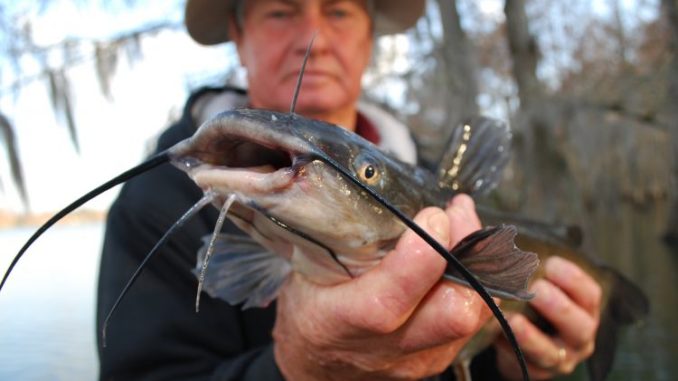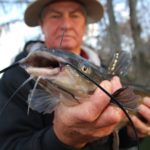
These cats are hard fighting and great to eat
After the expenditure of many hundreds of millions of dollars by lure makers and tournament sponsors, there is little doubt that the largemouth bass is America’s most popular freshwater fish.
But odds are strong that the second most popular fish is a surprise — the channel catfish.
It is the official state fish in five states, tying the more glamorous largemouth bass. An estimated 8 million U.S. recreational anglers target them, plus several thousand more commercial fishermen.
It was the first fish domesticated as a farm animal in North America and is still the most commonly farmed fish in the United States. A minor trade for albino specimens (that breed true) exists in the aquarium industry.
One of 45 members of the North American catfish family that live in the U.S., scientists know it by the name Ictalurus punctatus.
The translation is descriptive. In Greek “ichtys” means fish, and “ailouros” means cat. The punctatus part is Latin and means “spotted,” in reference to the black pepper-like dots sometimes found on fish smaller than 2 pounds.
Dedicated catfish fishermen shouldn’t be overawed by the number of catfish in the family. Thirty-one of them are madtoms — tiny (less than 2 inches long) creatures that live under rocks in streams — and two species are small, eyeless, unpigmented cave-dwellers that never see the light of day.
Of the remaining 12 species, seven are bullheads (dismissively called pollywogs or mud cats in Louisiana) with needle-sharp fins, super-slimy skins and red flesh that looks unappetizing, although it cooks up white and mild.
Louisiana fishermen are mainly interested in three species: blue catfish, flathead catfish and the most numerous channel catfish.
Flathead catfish don’t resemble anything else that swims in North America, but some fishermen confuse the identities of blue cats and channel cats. Both have deeply forked tails and both are, depending on water color, an overall gray.
Fisheries biologists usually refer fishermen to the fishes’ anal (belly) fin for identification. The blue catfish’s fin has a perfectly straight edge and 30 to 35 rays. The bottom edge of the anal fin in channel catfish is noticeably bowed or arched.
I use a simple glance at the whiskers located on the sides of their mouths. Blue catfish whiskers are always the same color as their bodies and are shorter and thinner than those of channel catfish. Channel cat whiskers are much darker than the rest of the body, and are much longer and thicker than blue cat whiskers.
Their fillets are easier to tell apart than are the live fish. Wild (not farm-raised) channel catfish fillets have a bright, butter-yellow tinge on the top edge of each fillet.
Channel catfish have a huge range and swim in almost all waters within that range except very cold trout streams. They are found extending in the west from Montana southward through New Mexico throughout the American heartland, including the Great Lakes, to the Appalachian Mountains in the east.
They swim through waters in a large swath of eastern Mexico, many of the rivers draining into the Great Lakes, and in the Red River of the North, which forms the boundary between North Dakota and Minnesota and flows due north for 545 miles before emptying into Lake Winnipeg in Manitoba, Canada.
Because they are fine fighters, thrive in tough circumstances and are good table fare, humans have introduced them to establish breeding populations into every state in the west in which they were not native, as well as every state with waters draining from the Appalachian Mountains into the Atlantic Ocean, and all the New England states except Maine.
Outside their native range, biologists accuse the fish of causing much mischief, hybridizing with the threatened Yaqui catfish in Mexico, eating out native crawfish populations, choking endangered Colorado pikeminnows that try to eat them, preying on endangered or threatened trout-perch, humpback chub, razorback suckers and Chiricahua leopard frogs.
Channel cats live in the Mississippi, Missouri, and Ohio rivers, as well as small rapidly flowing streams, natural lakes, farm ponds, large and small man-made reservoirs, and downstream from the turbulent discharges of major dams. They are found over slushy, muddy, clay, sand and rocky bottoms.
In flowing waters, larger fish often lie up in deep holes and under log jams during daylight hours, coming out to rove and feed over shallow sandbars at night and in daylight during periods of rising river waters caused by runoff.
Trotlines and jug lines fished over sandbars during these conditions are often very productive.
Channel catfish do not grow as large as their blue catfish (record: 143 pounds) or flathead catfish (record: 123 pounds) relatives.
The IGFA record channel catfish is a freakishly large 58-pounder taken from Santee-Cooper Reservoir in South Carolina in 1964.
Realistically, any channel catfish over 20 pounds is a spectacular specimen. For some reason, while they are very common in Louisiana, one larger than 5 pounds is very rare.
When someone in the South thinks of channel catfish, he might think of many things — running trotlines after dark, fried catfish and hush puppies, hoop nets loaded with thrashing fish, or maybe even catfish farms — but never trophy catfish.
But a managed trophy catfish fishery does exist, in of all places the aforementioned Red River of the North. Trophy regulations on the river provide for a low daily limit and a limit of one fish over 24 inches long.
Records from this river are a 38-pounder for Minnesota, a 42-pounder for North Dakota, and a 47-pounder for Manitoba, in spite of a short growing season. Scientist attribute the large size of channel catfish in the river to their long life spans, which stretch to as long as 24 years.
A 1998 survey showed anglers traveling from 15 states to fish the Red’s big catfish and spending a lot of money to do so. Doug Stange, the editor of In-Fisherman magazine who is among the “who’s who” of catfish angling, referred to the Red as a “crown jewel” and a “national treasure.”




